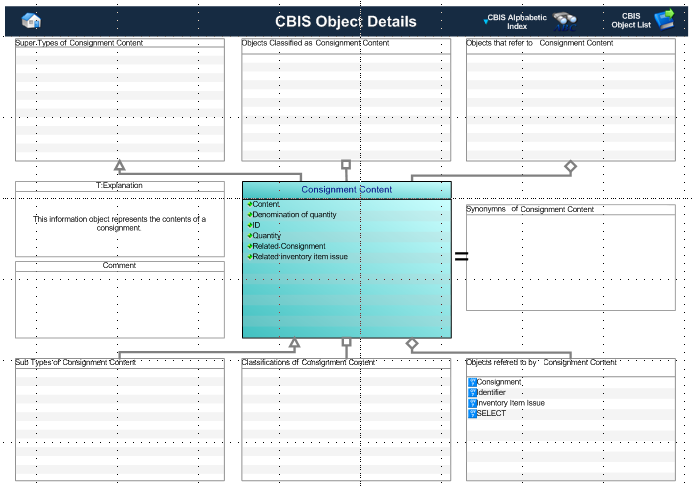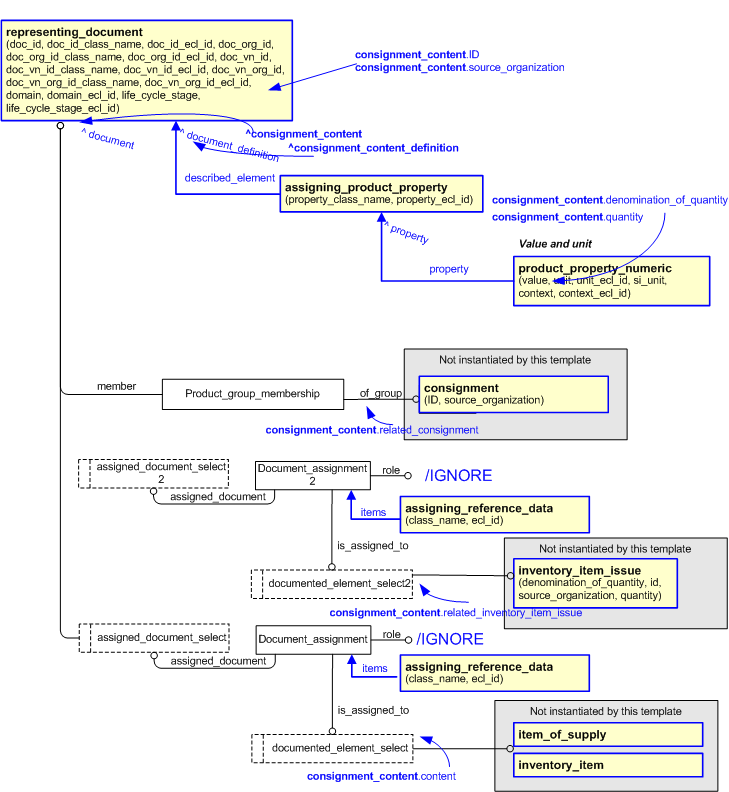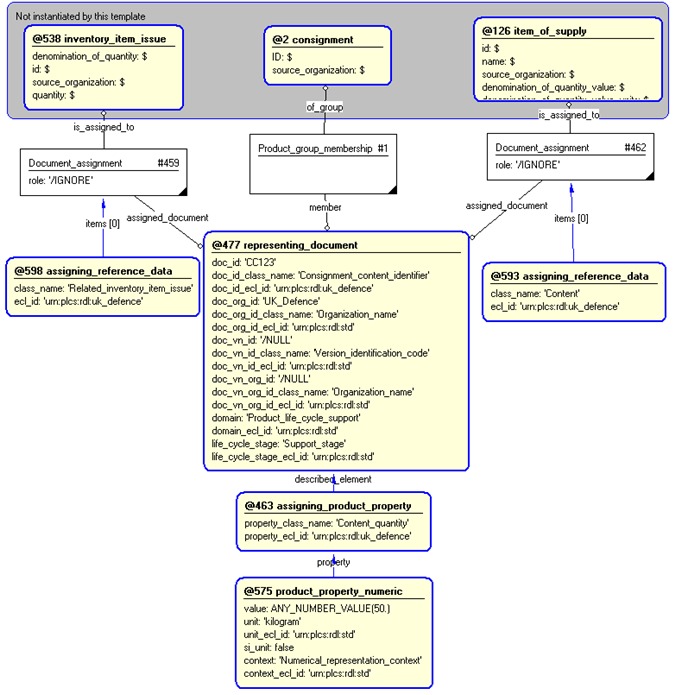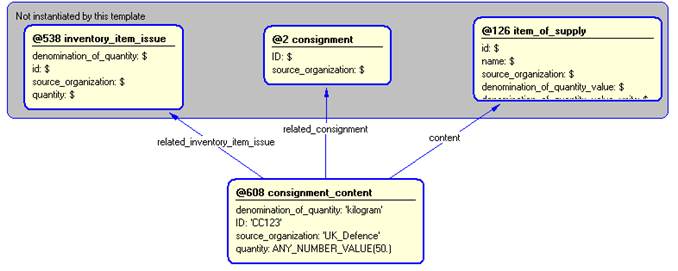Template:— consignment_content (conmt_con)
Context:— UK_Defence |
Date: 2009/04/17 10:53:54
Revision: 1.3
|
This section specifies the template consignment_content.
NOTE
The template has been defined in the context of
UK_Defence.
Refer to the business context for details of related templates.
NOTE
An explanation of a template and the associated instantiation path is
provided in the
Template overview
section.
This template describes how to represent the contents of a consignment.
This information object represents the contents of a consignment..
Figure 1 — Graphical Representation for Business Object Consignment Content
Consignment Content:
|
Attribute name
|
Attribute description
|
Attribute type
|
Optionality
|
| Content |
This is the reference to the content of the related consignment |
Relationship to SELECT of Inventory Item or Item of Supply |
Mandatory |
| Denomination of quantity |
This is the denomination quantity of the content item.
EXAMPLE:
- Box of 100
- 25kg bag
- Each
|
Intrinsic |
Mandatory |
| ID |
This is the identifier of the consignment content |
Relationship to Identifier |
Mandatory |
| Quantity |
This is the quantity of the content that is contained in the related consignment. |
Intrinsic |
Mandatory |
| Related Consignment |
This is the reference to the consignment that contains the related contents. |
Relationship to Consignment |
Mandatory |
| Related inventory item issue |
This is the reference to the inventory item issue that has lead to the creation of the consignment content. |
Relationship to Inventory item issue |
Mandatory |
Table 1 — Consignment Content attribute details:
The EXPRESS-G diagram in
Figure
2
shows the templates and EXPRESS entities that are required
to represent the template
"consignment_content".
The text highlighted in blue shows the template parameters.
Figure 2 — An EXPRESS-G representation of the Information model for consignment_content
The graphic for the template to be used in other EXPRESS-G diagrams
is shown in Figure
3
below.
Figure 3 — The graphical representation of the consignment_content template
The following input parameters are defined for this template:
This is the reference to the content of the related consignment
This is the denomination quantity of the content item.
The following classes and their sub-classes can be used:
This is the identifier of the consignment content.
The organization that created the associated identifier. Additionally
a Person or Information System could be defined when either of these are the source; see Identifier template characterizations
This is the quantity of the content that is contained in the related consignment.
The data type must also be indicated in this parameter, e.g.
"ANY_NUMBER_VALUE(5)".
This is the reference to the consignment that contains the related contents.
This is the reference to the inventory item issue that has lead to the creation of the consignment content.
The following reference parameters are defined for this template:
Allow the
Document
entity instantiated in this path to be referenced when this template is used.
Note: The
Document
entity can be referenced in a template path by:
%^target = $consignment_content.consignment_content%
where
target
is the parameter to which the
Document
is bound.
Allow the
Document_definition
entity instantiated in this path to be referenced when this template is used.
%^target = $consignment_content.consignment_content_definition%
The following parameter combinations specify a uniqueness constraint:
Unique constraint: Consignment_content
Each instance of the
entity
(
Document)
within the data set shall be uniquely identified
by a combination of the following parameters on this
template (consignment_content) namely:
ID,
content,
related_consignment.
The
instance is
referenced by the following template parameter:
consignment_content.
The instantiation path shown below specifies the entities that are to be
instantiated by the template.
A description of templates and the syntax for the instantiation path is
provided in the
Templates Help/Information section.
-- Representing document /
representing_document(
doc_id=@ID,
doc_id_class_name='Consignment_content_identifier',
doc_id_ecl_id='urn:plcs:rdl:uk_defence',
doc_org_id=@source_organization,
doc_org_id_class_name='Organization_name',
doc_org_id_ecl_id='urn:plcs:rdl:std',
doc_vn_id=/NULL,
doc_vn_id_class_name='Version_identification_code',
doc_vn_id_ecl_id='urn:plcs:rdl:std',
doc_vn_org_id='/NULL',
doc_vn_org_id_class_name='Organization_name',
doc_vn_org_id_ecl_id='urn:plcs:rdl:std',
domain='Product_life_cycle_support',
domain_ecl_id='urn:plcs:rdl:std',
life_cycle_stage='Support_stage',
life_cycle_stage_ecl_id='urn:plcs:rdl:std')/
%^consignment_content = $representing_document.document%
%^consignment_content_definition = $representing_document.document_definition%
-- Content Document_assignmentDocument_assignment.role = '/IGNORE'
Document_assignment.assigned_document ->
^consignment_content
Document_assignment.is_assigned_to ->
@content%^content =
Document_assignment%
-- assigning_reference_data /
assigning_reference_data(
items=^content,
class_name='Content',
ecl_id='urn:plcs:rdl:uk_defence')/
-- instantiate quantity and unit class /
assigning_product_property(
property_class_name='Content_quantity',
property_ecl_id='urn:plcs:rdl:uk_defence',
described_element=^consignment_content_definition)/
%^property = $assigning_product_property.property%
-- instantiate Batch quantity /
product_property_numeric(
value=@quantity,
unit=@denomination_of_quantity,
unit_ecl_id='urn:plcs:rdl:uk_defence',
si_unit='false',
context='Numerical_representation_context',
context_ecl_id='urn:plcs:rdl:std',
property=^property)/
-- link to related_analysis Product_group_membershipProduct_group_membership.member ->
^consignment_content
Product_group_membership.of_group ->
@related_consignment-- Content Document_assignmentDocument_assignment.role = '/IGNORE'
Document_assignment.assigned_document ->
^consignment_content
Document_assignment.is_assigned_to ->
@related_inventory_item_issue%^rel_item_issue =
Document_assignment%
-- assigning_reference_data /
assigning_reference_data(
items=^rel_item_issue,
class_name='Related_inventory_item_issue',
ecl_id='urn:plcs:rdl:uk_defence')/
The following entities are instantiated with attributes as specified:
The instance diagram in Figure
4
shows an example of the EXPRESS entities and templates that are instantiated by the template:
/consignment_content(content='@126', denomination_of_quantity='kilogram', quantity='ANY_NUMBER_VALUE(50.)', related_consignment='@2', related_inventory_item_issue='@538')/
(an illustration of the consolidated consignment_content template is shown in
Figure
5 below.)
Figure 4 — Entities instantiated by consignment_content template
The instance diagram in
Figure
5
shows the graphic symbol for the template that is to be
used in other instance diagrams. The example template is:
/consignment_content(content='@126', denomination_of_quantity='kilogram', quantity='ANY_NUMBER_VALUE(50.)', related_consignment='@2', related_inventory_item_issue='@538')/
Figure 5 — Instantiation of consignment_content template
Characterizations
No common characterizations of the template
consignment_content
have been identified. However, the ISO 10303-239 EXPRESS model
may enable other assignments to the entities instantiated by the template.




